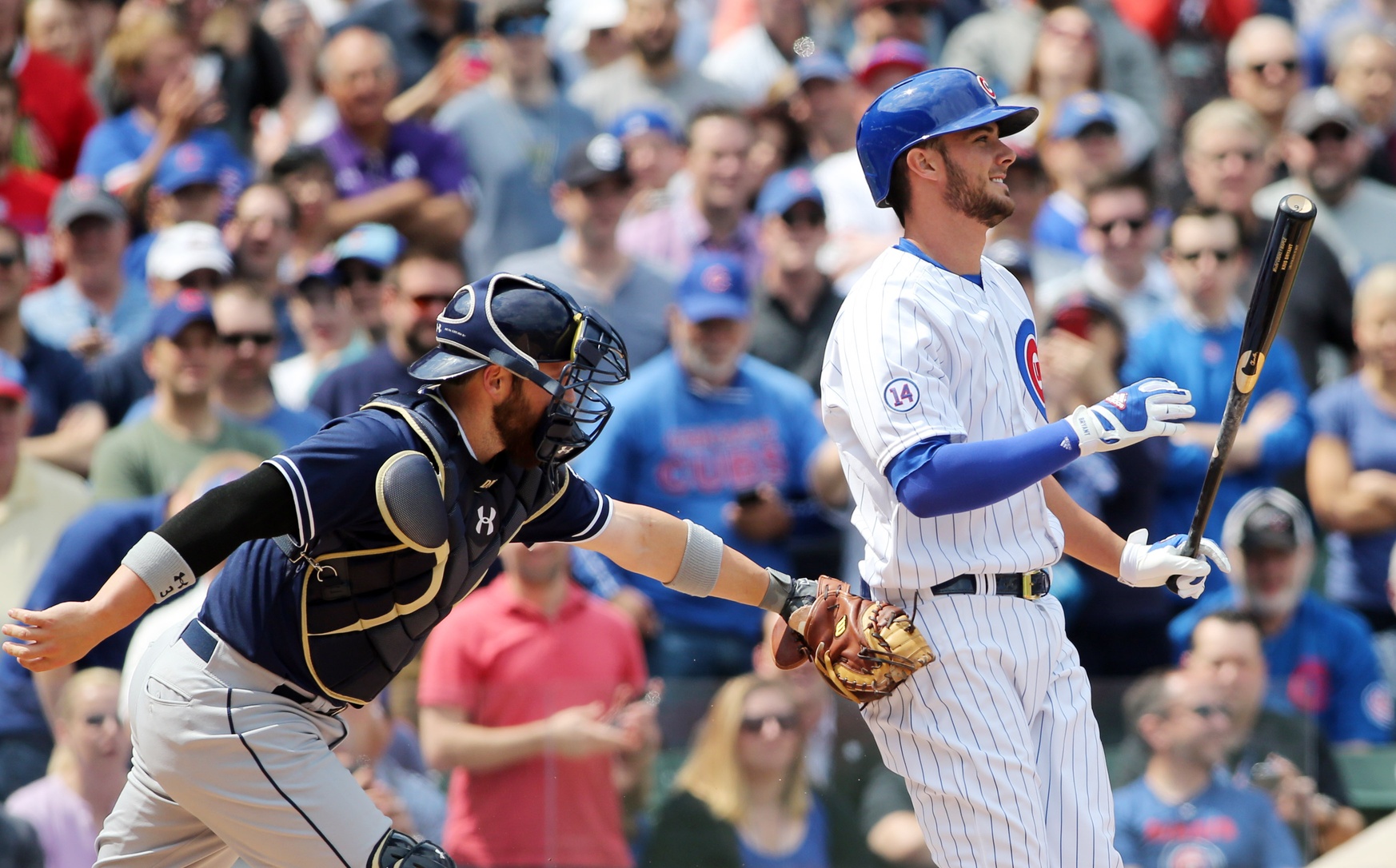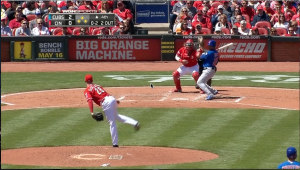Photo courtesy of Jerry Lai-USA TODAY Sports
There were a lot of problems with the 2014 Cubs. The biggest one, obviously, was that they didn’t win enough games. That’s what we call the ultimate problem, and that’s what the Cubs front office went into the offseason intending to address. They did so by solving a number of proximate problems—the problems that they believed, taken together, caused the ultimate problem. The team didn’t have anyone they trusted to play center field, or to hit leadoff, so they acquired Dexter Fowler, who could do both. The team didn’t have a proven ace, so they acquired Jon Lester. And the team didn’t have Joe Maddon, so they acquired him too.
These acquisitions have solved a lot of proximate problems, and seem to have made some progress towards addressing the ultimate problem (that is, the lack of wins). As of this writing, the Cubs have the fourth best record in the National League. But adding players and coaches wasn’t the only way the Cubs went about solving their ultimate problem. They also tried to change the nature of the players they already had under their control. Just as they acquired many different players, they tried to change the ones they already had in a lot of different ways. But for this article, I am concerned with just one of those ways. Specifically, I am interested in the fact that the Cubs tried to teach their hitters to adopt a different approach during two-strike counts than they had previously employed.
John Mallee, the Cubs hitting coach, explains why (quoted by ESPN):
[I want] a hitter to stay within his strengths until two strikes … [then], if [you] get the ball in play, [you] have a chance to hit .300.
Mallee is referring to league average batting average on balls in play (BABIP), which hovers around .300 for most players. His theory is that when you have two strikes, you’re better off shortening up your stroke and making contact—any contact—because the ball just might drop. Indeed, last year, the Cubs’ batting average on balls in play with two strikes was .299. That’s a lot better than striking out; even if the ball doesn’t drop, you just might move the runner over. Thus, the Cubs, this offseason, tried to teach their hitters to shorten up with two strikes and just put the ball in play.
Given the emphasis Mallee (and, to some extent, Maddon) put on that reformed two-strike approach during spring training, I wanted to dig into the numbers and see if we could see any early improvements in that department for the 2015 Cubs. The early results are, to be honest, a little disappointing. Here are a few numbers for the Cubs on plate appearances that reached a two-strike count, in 2014 and then in 2015.
| Year | AVG | OBP | SLG | OPS+ | K% | BB% | BIP% |
| 2014 | .162 | .220 | .244 | 83 | 45.5 | 6.3 | 47.5 |
| 2015 | .152 | .227 | .232 | 81 | 45.3 | 8.0 | 45.8 |
Yeesh. I suppose if you were reaching for something positive, you could say the Cubs are coming back to work walks a little bit more this year than last, but that’s about it. You’re looking at two basically identical batting lines. In my search for a silver lining, I initially wondered if an improved approach might be manifesting in a smaller number of two-strike counts (i.e. the Cubs might be shortening up earlier in the count, thus limiting the number of two-strike counts), but no. In 2014, the Cubs averaged 20.0 two-strike plate appearances per game; in 2015, that number is an essentially identical 20.5. The numbers are clear: at least by results, the Cubs this year are the same as the Cubs last year with two strikes.
But results and approach are two different things, and I’ve only looked at one of them so far. Let’s take a look at a few more interesting things, this time relating to approach. First, the Cubs are currently averaging 3.94 pitches per plate appearance—the fourth best number in the league and an improvement over last year’s 3.89. Part of that improvement—which aids the team by both exposing the pitcher to observation from the dugout and by tiring him, and in turn hopefully getting to the bullpen faster—could certainly come from an improved two-strike approach.
The way to find that out would be to look at the average length of the Cubs’ plate appearances that included a two-strike count in 2015, and compare that to the equivalent number for 2014. Thanks to the magic of the Baseball Prospectus stats team, we are able to do exactly that. In 2014, the Cubs averaged 5.05 pitches per plate appearance that included a two-strike count. In 2015, they are averaging 5.12 pitches in such plate appearances. That’s a 1.4 percent improvement, which is marginal at best, but it is an improvement, and puts the team in the top half in baseball in that metric (exactly 15th, actually).
No roundly positive signs there. But we can go even further in search of good news. What Mallee wants the Cubs to do with two strikes is, essentially, shorten up their swings, either to foul off pitches they can’t put in play (and extend the at-bat) or to put the pitches they can put in play, in play. With the kind of approach he wants, then, we should hope to see Cubs batters fouling off more pitches in two-strike counts than they did last year. And, now courtesy of Baseball Savant, we can take a look at that too. Out of 712 pitches seen with two strikes in 2015, the Cubs have been able to foul off 142, or 19.9 percent. In 2014, the Cubs saw 6,867 pitches with two strikes, and fouled off 1,547, or 22.5 percent. That’s not particularly good. In a season where we would hope the Cubs are fouling off more two-strike pitches, they’re actually fouling off less—11.6 percent less.
Our search for evidence of an improved approach has been rather dispiriting so far. Let’s see, lastly, if this ‘short’ approach has led to a different batted-ball profile for the Cubs this year. With a shorter swing, you’d probably expect to see more ground balls, and maybe more line drives, than fly balls. It’s just harder to generate loft when you’re short to the ball. Well, here’s the Cubs’ batted-ball profile for plate appearances that reached a two-strike count this year, compared to 2014:
| Year | Total Pitches | Line Drives % | Ground Ball% | Fly Ball % | LD + GB % |
| 2014 | 6,867 | 5.8 | 10.0 | 5.8 | 15.8 |
| 2015 | 712 | 5.2 | 11.1 | 4.9 | 16.3 |
Well, there’s something somewhat positive. We see a 15.6 percent drop in the number of fly balls the Cubs have generated in two-strike counts, and a moderate (3.2 percent) increase in the number of ground balls and line drives they’ve generated combined. Maybe this is something in the Cubs’ approach that’s working.
That said, it’s pretty clear from the numbers that the results haven’t been there yet for the Cubs, at least with respect to their two-strike approach. But that doesn’t mean that the approach isn’t there, and that it won’t start working in the future. For now, we can say this: the Cubs have gotten a little bit better at taking more pitches per plate appearance with two strikes, a little bit worse at fouling off pitches with two strikes, and a little bit better in reducing fly balls when they do make contact with two strikes. Those facts, combined with the Cubs’ relatively soft .274 BABIP with two strikes this year, suggest that there’s possibly a tiny bit of improvement already, and definitely room for more.
Despite the lack of overall results, however, there are already moments in-game when you can dream on the changes the Cubs are seeking. Here’s one of them, featuring newest Cub Addison Russell. In the top of the fourth inning of Sunday’s game, with the bases loaded and two outs, Russell quickly found himself down 0-2 against the Reds’ righty Anthony Descalfani. The next pitch looked like this:
Russell didn’t need an improved approach to lay off that one; it nearly got him in the head. The next two pitches are where it gets interesting. They were both down and off the plate. And Russell fouled both of them off. Now we’re at a 1-2 count, with Russell having proved his ability to foul off the pitch down and away. Descalfini decides to change his approach, and comes in over the plate. Which is what allowed Russell to do this:
All three runs scored on the double, and the Cubs won the game, 5-2. If Russell hadn’t proven his ability to foul off the pitches outside with two strikes, Descalfini wouldn’t have had to come in over the plate in search of a called third strike, and Russell wouldn’t have been able to drive in the winning runs. That’s what an advanced two-strike approach can do for you, and that’s what the Cubs are hoping to achieve. They just aren’t there yet, as far as we can tell.

